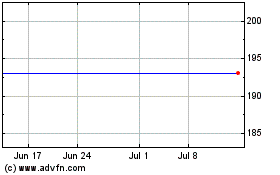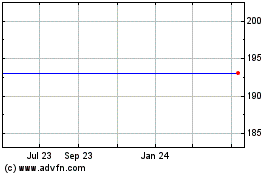(FROM THE WALL STREET JOURNAL 11/24/15)
By Jonathan D. Rockoff
The $155 billion agreement to combine Pfizer Inc. with Allergan
PLC would create a drug behemoth so big that Pfizer is already
thinking of breaking it up.
The deal, which was announced Monday, brings together a diverse
stable of drugs, from Pfizer's cancer medicines and vaccines, to
Allergan's skin-care treatments and eye drugs.
The companies expect to achieve $2 billion in cost savings as
well as significant tax benefits from the deal, under which
Pfizer's tax base would shift to Allergan's home base in Ireland in
a so-called inversion. As a result of the move, Pfizer expects to
cut its tax rate to 17% or 18%, from its roughly 25% rate
currently, because corporate taxes in Ireland are lower than in the
U.S.
The new drug company would be the world's biggest with $63.5
billion in yearly sales, 110,000 employees and $9 billion in annual
research spending.
Pfizer executives have for years considered splitting the
company, but they have been deterred by concerns that its
businesses may not be large enough to stand alone. Now, with
Allergan, the company would have strength in both high-cost,
high-growth drugs as well as generic, lower-cost drugs to make such
a split.
On Monday, executives said they would consider splitting the
combined company into two by 2018.
One business would focus on newer products, such as Pfizer's
breast-cancer drug Ibrance and Allergan's blockbuster Botox, and
have sales the companies project will grow in the double
digits.
The other, with a potentially mid-single-digit growth rate,
would consist of older drugs that have lost patent protection or
are about to, such as Pfizer's Celebrex arthritis drug and
Allergan's Teflaro antibiotic.
The two businesses "may or may not fit" together, Pfizer Chief
Executive Ian Read said in an interview.
Shareholders would have preferred more certainty on a split,
according to analysts, because a breakup could increase the value
of their holdings. They were also disappointed, analysts said,
because Pfizer executives pushed back the timeline for making a
decision by two years, saying it wanted to first focus on properly
digesting Allergan.
The companies didn't want to drop the neutral tone Pfizer has
used to describe its deliberations because the drug maker doesn't
want to hurt employee morale, according to a person familiar with
the matter.
Shares in Pfizer fell 2.7%, while Allergan lost 3.4% Monday.
Another drag on the stocks: concern that the U.S. government
could try to thwart a combination that would move one of the top
names in corporate America to a foreign country.
However, despite new rules issued by the U.S. Treasury
Department last week to deter "inversion" deals, it is unlikely
that any significant changes to the corporate tax code are in the
offing without action by Congress. Pfizer structured the deal --
under which smaller Allergan is taking it over and Allergan
shareholders will control 44% of the combined company -- to help
bypass Treasury's efforts.
Mr. Read said the tax-restructuring would free up billions of
dollars in cash for use on drug research and other programs. That
cash was trapped overseas, because bringing it back to the U.S.
would have generated a huge tax tab.
"This just enables us to invest more in the U.S.," he said.
At the end of September, Pfizer had $37.6 billion in cash and
equivalents, most of that overseas, Pfizer Chief Financial Officer
Frank D'Amelio said.
For its part, the Irish government is sanguine about the deal,
since both pharmaceutical companies already employ thousands of
people in the country. A spokesman for Finance Minister Michael
Noonan said the only "major concern" was that the merger would
result in job losses. "We would be hoping that the merger would
result in an increase in employment here rather than a decrease,"
he said.
The deal values each Allergan share at $363.63, more than a 30%
premium to the price before The Wall Street Journal reported the
deal talks late last month. Allergan shareholders would get 11.3
shares in the combined company for each of their own, and Pfizer
stockholders could exchange some of their shares for cash.
Both Pfizer and Allergan have been whipsawed by integrations and
restructurings in recent years, a product of the seismic changes
that have been rippling through health care as a result of pressure
to control spending, the rollout of the Affordable Care Act, and
the end of a wave of patent expirations for top-selling drugs like
Pfizer's Lipitor cholesterol pills.
"Both companies and both sets of leaders have been transforming
their businesses," said Allergan CEO Brent Saunders in an
interview. Mr. Saunders will serve as president and chief operating
officer of the combined company and join its board.
After taking the helm of Pfizer in late 2010, Mr. Read
spearheaded a number of deals to focus the company on human
medicines and rebuild its pipeline. Pfizer spun off its
animal-health business, for instance, and most recently bought
Hospira for $16 billion.
Mr. Read also reorganized Pfizer into segments focusing on
patent-protected medicines and older drugs, a move that could pave
the way for a potential split.
Allergan has undergone an even bigger remodeling, since Paul
Bisaro took over a relatively small generic drug company called
Watson Pharmaceuticals in 2007. Watson expanded its portfolio of
the knockoff drugs through a series of deals, including one for the
European company Actavis, whose name the company took.
Last year, the company moved into patent-protected drugs by
buying Forest Laboratories -- whose CEO was Mr. Saunders -- and
then scooped up Allergan. Most recently, the company took a big
step toward moving on from its heritage, agreeing to sell its
generic-drugs business to Teva Pharmaceutical Industries Ltd. for
$40.5 billion. Mr. Bisaro, currently the executive chairman of
Allergan, will join the board of the new company.
---
Denise Roland contributed to this article.
Subscribe to WSJ: http://online.wsj.com?mod=djnwires
(END) Dow Jones Newswires
November 24, 2015 02:47 ET (07:47 GMT)
Copyright (c) 2015 Dow Jones & Company, Inc.
Allergan (NYSE:AGN)
Historical Stock Chart
From Mar 2024 to Apr 2024

Allergan (NYSE:AGN)
Historical Stock Chart
From Apr 2023 to Apr 2024
